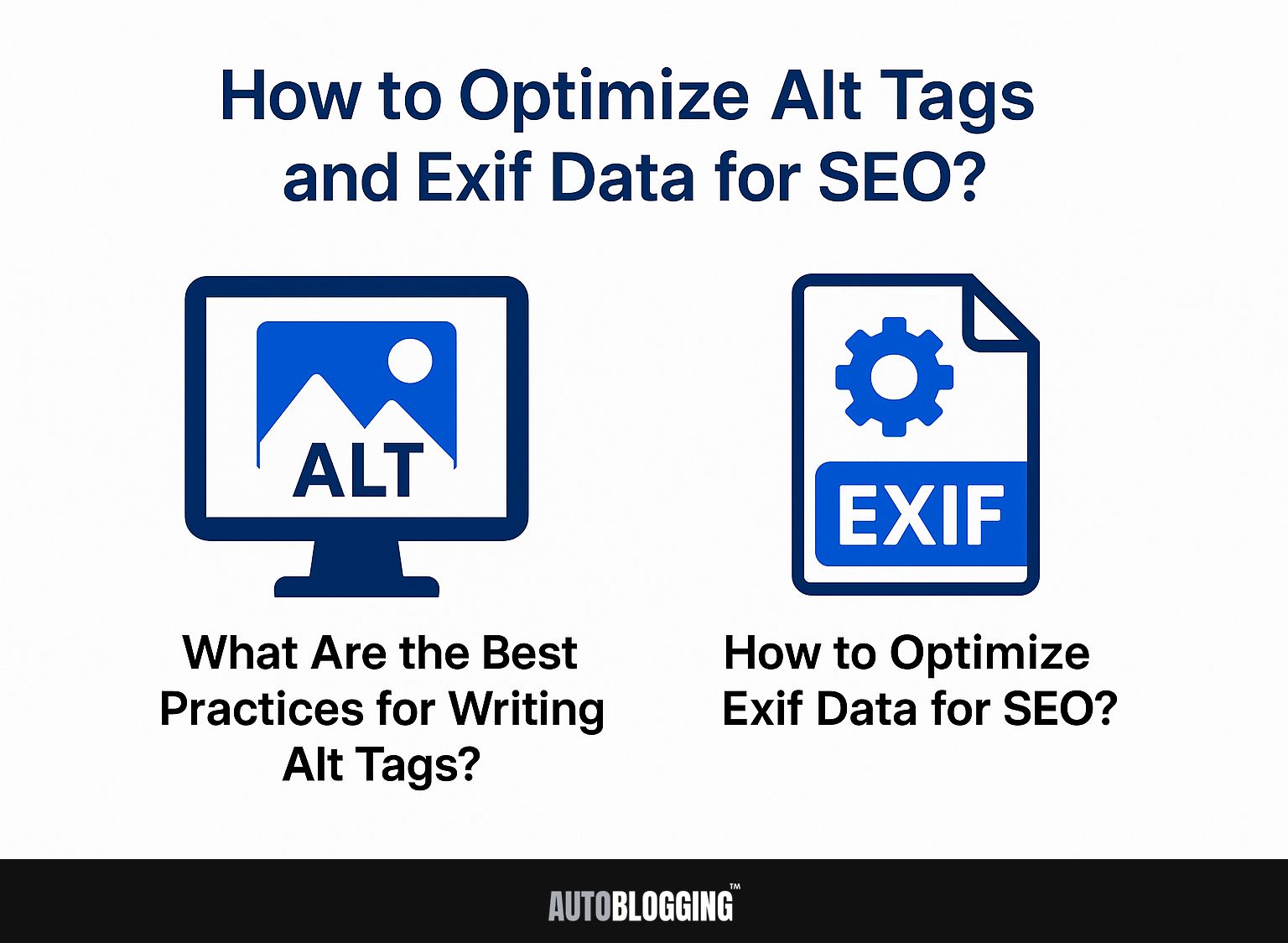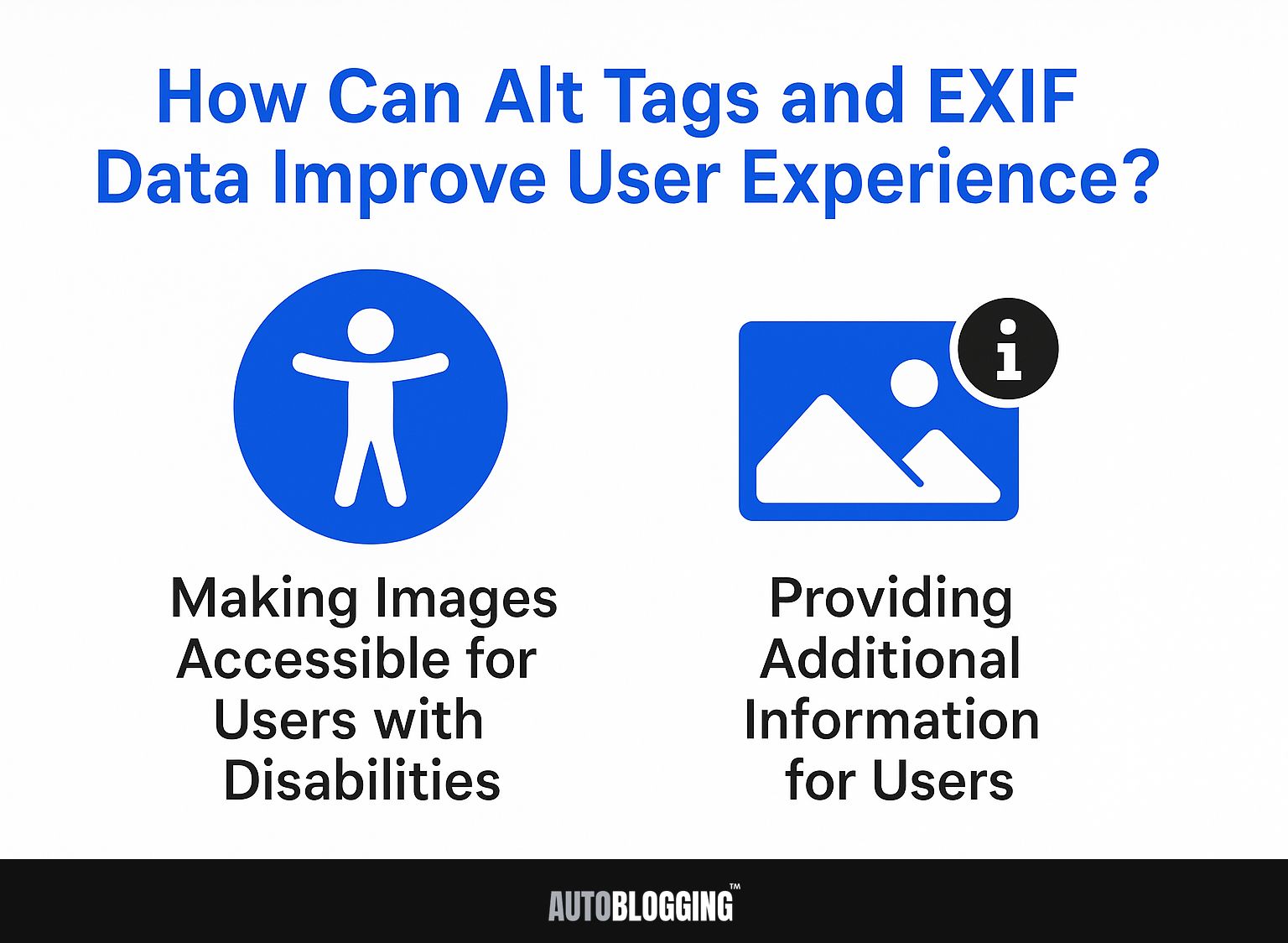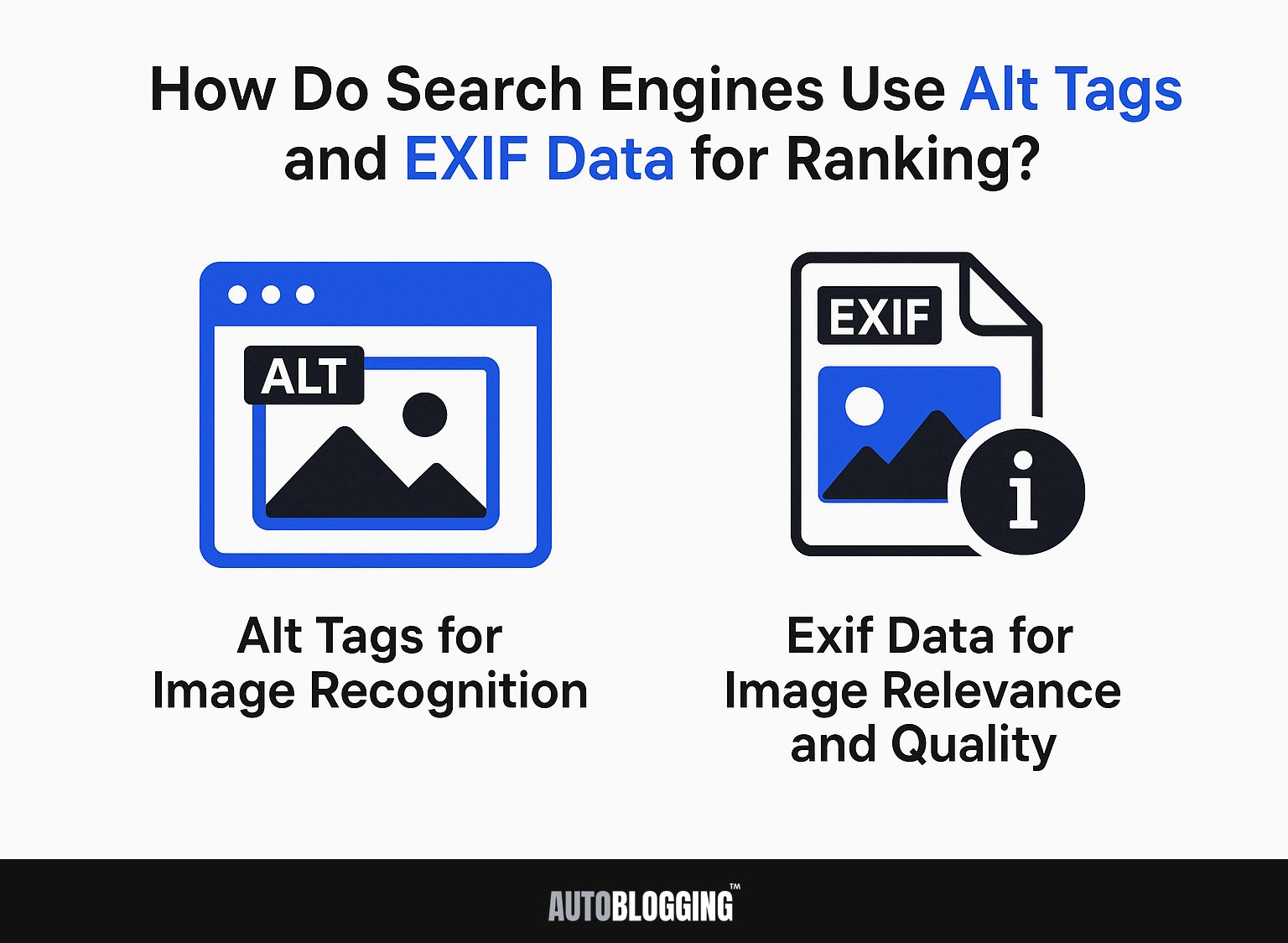In the online world, where images are important for capturing people’s interest, grasping Alt tags and Exif data is essential for enhancing a website’s SEO. These often ignored details help search engines organize images and make it easier for users to find and understand the content.
This article looks at the importance of Alt tags and Exif data, their impact on SEO “, and the best ways to make them work better.” Learn how using these tools can improve your skills online presence and connect with your audience more effectively.
Key Takeaways:
- Alt tags and Exif data are important for SEO as they provide additional information about images to search engines and improve user experience.
- To improve Alt tags, write detailed descriptions with relevant keywords and update them when adding new images. For Exif data, include relevant keywords in file names and descriptions.
- Common mistakes to avoid when using Alt tags and Exif data for SEO include using generic tags, not including keywords, and not updating for new images.
Contents
- What Are Alt Tags and Exif Data?
- Why Are Alt Tags and Exif Data Important for SEO?
- SEO Impact of Alt Tags and Exif Data Statistics
- How to Improve Alt Tags and Exif Data for SEO?
- What Are the Common Mistakes to Avoid When Using Alt Tags and Exif Data for SEO?
- How Can Alt Tags and Exif Data Improve User Experience?
- How Do Search Engines Use Alt Tags and Exif Data for Ranking?
- Frequently Asked Questions
- 1. What are Alt Tags and how do they help with SEO?
- 2. Why is it important to include Alt Tags for images on a webpage?
- 3. How should you write Alt Tags for SEO?
- 4. What is Exif Data and how does it contribute to SEO?
- 5. Can adding Alt Tags and Exif Data to images on a webpage improve its ranking on search engines?
- 6. Are Alt Tags and Exif Data the only factors that affect SEO for images?
What Are Alt Tags and Exif Data?
Alt tags, also called alt attributes or alternative text, are HTML elements that explain the content of images on a webpage. They help with accessibility and search engines.
Exif data (Exchangeable Image File Format) includes metadata that is automatically saved with images, such as camera settings and location details. Both are important for improving image SEO and increasing SEO rankings on Google Image search results. For more insights on optimizing these elements, industry leaders such as the team at Yoast provide comprehensive guides on image SEO strategies.
Why Are Alt Tags and Exif Data Important for SEO?
Alt tags and Exif data are important for SEO rankings because search engines use these elements to understand the content of images and improve indexing.
By clearly describing images with helpful alt text and adding Exif data, web content can rank higher in search engine results, resulting in more clicks and improved user interaction. For those interested in a comprehensive overview, this analysis by Yoast covers the full spectrum of implications and offers practical tips on how to optimize alt text and title tags effectively.
SEO Impact of Alt Tags and Exif Data Statistics
Alt Text and SEO Optimization: Image Alt Text and Keyword Usage
The SEO Impact of Alt Tags and Exif Data Statistics focuses on the role of alt text in improving search engine results, stressing how using keywords properly can make images more visible and websites easier to use.
Alt Text and SEO Optimization focuses on the strategic use of image alt text, with a recommended 30% optimal keyword usage. This percentage suggests incorporating keywords in alt text to improve image searchability without compromising content quality or appearing spammy. Keywords in alt text help search engines understand image context, contributing to improved SEO performance.
- Image Alt Text and Keyword Usage: While embedding keywords in alt text is beneficial, overuse can lead to penalization. The data alerts against 70% keyword usage or higher, which risks being flagged as keyword stuffing. Using too many keywords can negatively affect search rankings and make it hard for users to read, showing the need for balance when writing good alt text.
Effective alt text contributes to accessibility, ensuring that visually impaired users using screen readers can understand image content. Alt text should be descriptive yet concise, prioritizing clarity over excessive keyword insertion.
Overall, the data highlights the important balance needed in using alt text for SEO. Keeping keyword usage at 30% helps improve performance while preventing any negative consequences. Descriptive alt text improves accessibility, helping both search engine optimization and user experience.
What Are the Benefits of Using Alt Tags and Exif Data for SEO?
Using alt tags and Exif data helps with SEO by improving image search results, making content usable for people with vision problems, and enhancing how users interact with the site. By using these metadata standards, online businesses can improve their product images, which helps them rank higher in search engine results and makes them more visible.
Correctly used alt tags can greatly improve a website’s accessibility. They help screen readers describe images to users with visual impairments.
Statistics indicate that around 15% of people globally live with a disability, highlighting the importance of this feature to allow everyone to take part.
In addition, search engines like Google prioritize websites that offer an accessible environment, which can improve overall search engine indexing.
This means that images accompanied by descriptive alt text often rank higher in image search results, driving more organic traffic. Therefore, these practices encourage inclusivity and provide a smooth experience, which keeps users interested and increases conversion rates for businesses.
How to Improve Alt Tags and Exif Data for SEO?
Improving alt tags and Exif data for SEO is important for increasing image visibility in search engines and following Google rules.
This task involves precisely adding relevant words in alt text and ensuring the Exif data contains necessary details, such as copyright, licensing information, and other important attributes that help images function effectively.
1. What Are the Best Practices for Writing Alt Tags?
Effective alt tags should clearly explain what the image depicts and comply with accessibility guidelines, ensuring compatibility with screen readers. By focusing on keyword optimization without engaging in keyword stuffing, web content can significantly improve its visibility and ranking on search engines.
To create alt text that is both informative and search-engine-friendly, aim for a character limit of around 125 to 150 characters, encapsulating the essence of the image without overwhelming it with information.
For example, instead of only saying ‘dog,’ a more detailed alt tag could be ‘Golden Retriever chasing a ball in a sunny park.’ This describes what is happening and naturally includes relevant keywords.
Common pitfalls to avoid include writing vague descriptions like ‘image001’ or overly verbose alternatives that detract from the intended meaning. Writing clearly and including important words makes it easier to understand and helps with search engine results.
2. How to Optimize Exif Data for SEO?
To improve Exif data for SEO, make sure all important metadata guidelines are followed, such as giving clear copyright information and other key details that can help with image indexing. Properly formatted Exif data can also include aspects such as image compression settings and licensing information, which can influence how search engines recognize and rank images.
Along with these fundamentals, users should be aware of the various tools available for managing and editing Exif data effectively. Software such as Adobe Photoshop provides simple access to the image’s metadata settings, where users can add or change descriptions, keywords, and other details to make the image content and background clearer. A useful resource on understanding these aspects is available on Format’s guide to photo metadata, which offers insights into optimizing image data.
It’s important to check and change the Exif data often, particularly if the images are used again or for different purposes, so they stay current and correctly described. Improving Exif data helps search engines index better and increases user interaction by clearly showing the worth and ownership of the images.
What Are the Common Mistakes to Avoid When Using Alt Tags and Exif Data for SEO?
When using alt tags and Exif data for SEO, it is essential to avoid common errors to keep SEO rankings and make image optimization more effective.
Typical mistakes include:
- Using generic text for alt tags,
- Not including keywords in both alt tags and Exif data, and
- Failing to update these elements when new images are added, which can greatly affect search engine performance.
1. Using Generic Alt Tags
One of the most detrimental errors in image SEO is using generic alt tags, which fail to provide descriptive text and context about the image, reducing potential SEO rankings. These tags are often irrelevant and don’t use keywords effectively, which can result in lost chances for better visibility in Google Image search results.
For example, an alt tag like ‘photo123.jpg’ gives little information about the image. A label like ‘colorful sunset over the Grand Canyon’ clearly describes what the picture shows.
Using clear and detailed alt text helps visually impaired users and helps search engines understand the content. This can result in more user interaction and improved SEO results since search engines prefer visually appealing pages with relevant alt text.
2. Not Including Keywords in Alt Tags and Exif Data
Leaving out important keywords in alt tags and Exif data can greatly impact how easily images are found and how well they perform in search engine rankings, as search engines use these details to grasp the content. Avoid keyword stuffing, as it can result in penalties and lower content quality.
Finding the right balance is important; using keywords effectively increases visibility without losing the quality of the information.
When using keywords, focus on words that clearly describe the image instead of repeating them unnecessarily. To achieve this balance, use descriptive phrases that connect with users and give context.
Using different words and focusing on similar ideas can improve the content without making it too complex. Updating alt tags and Exif data with new and relevant keywords can improve search rankings and draw organic traffic, while keeping a good user experience.
3. Not Updating Alt Tags and Exif Data for New Images
Failing to update alt tags and Exif data for new images can detrimentally impact image indexing and overall SEO rankings, as search engines may struggle to categorize and rank the content appropriately. Adding clear alt text and accurate Exif data to every new image is important for good image SEO.
Regularly reviewing and enhancing these elements helps search engines comprehend the images better and improves the user experience by providing clear details.
A useful approach is to use a consistent naming system and checklist for each new upload. Make sure the alt tags correctly describe the image content and include important keywords.
Scheduling periodic audits of the image library can help identify and rectify any outdated entries. By focusing on these updates, content creators can greatly improve their presence in search results, leading to more natural visitors to their site and increasing overall performance.
How Can Alt Tags and Exif Data Improve User Experience?
Alt tags and Exif data help users by making content easier to access. This is especially important for people with visual impairments who use screen readers to go through web content.
Adding these elements helps meet accessibility standards and improves the way users interact with images on a site.
1. Enhancing Image Accessibility for People with Disabilities
One of the main purposes of alt tags is to make images accessible to users with disabilities. They offer important information and descriptions that screen readers can read aloud, helping visually impaired users to grasp the content on a webpage. This practice aligns with the Americans with Disabilities Act and promotes inclusivity in web design.
By using descriptive alt text, designers create a better experience for people with visual impairments, and improve the overall user experience.
Saying just ‘dog’ doesn’t give many details. Describing ‘Golden Retriever running after a red ball in a bright park’ clearly shows the action.
Following Web Content Accessibility Guidelines (WCAG) helps meet legal standards and makes websites usable for all people, including those with disabilities.
2. Providing Additional Information for Users
Alt tags and Exif data provide additional information to users about images, making it easier for them to grasp and engage with the pictures on a webpage. Extra details can help make the user experience better by adding useful information that isn’t obvious just from looking at the image.
For example, a photo of scenery might have an alt tag that explains the view, when it was taken, and where it is, helping to give a better idea in your mind.
Similarly, Exif data can reveal essential details such as camera settings and the photographer’s intent, which can intrigue photography enthusiasts and aspiring creators.
Websites can connect better with their audience by using descriptive captions that explain the meaning and importance of images, making visuals clearer and more engaging. This practice helps visually impaired users with screen readers and improves browsing for all visitors.
How Do Search Engines Use Alt Tags and Exif Data for Ranking?
Search engines use alt tags and Exif data to rank images and understand their place in web pages. When search engines examine these metadata details, they can index images more precisely. This ensures that the correct content appears in search results, influencing the overall ranking and visibility on Google Image search pages.
1. Alt Tags for Image Recognition
Alt tags are important for search engines to understand images. They give information for correctly organizing and listing images. This recognition is important for deciding how search results are ranked. Well-written alt tags can make sites more noticeable and increase the number of clicks.
By including relevant words and clear explanations, alt text helps search engines grasp what an image shows. It also improves the experience for users who use screen readers.
Describing ‘golden retriever playing fetch in a sunny park’ is clear, whereas using vague terms like ‘dog’ or ‘image123’ lacks detail.
Using alt tags for images helps improve a website’s SEO, leading to more interaction and reaching more people.
2. Exif Data for Image Relevance and Quality
Exif data plays an important role in conveying image relevance and quality to search engines, as it contains critical metadata about the image, including its origins and technical specifications. This information aids in image indexing, allowing search engines to evaluate the quality and context of the images, which can influence their ranking in search results.
If an image has location details, it is more likely to show up in local search results, helping people find specific places.
Details about camera settings, like shutter speed and aperture, can indicate skill and improve how people view the quality of the image.
Including details like the date the photo was taken or the subject matter can provide search engines with more context, enhancing the likelihood of the image appearing in relevant queries.
Improving Exif data strengthens an SEO plan, leading to higher user interaction and attracting more visitors naturally.
Frequently Asked Questions
1. What are Alt Tags and how do they help with SEO?
Alt Tags, also known as alternative text, are HTML attributes used to describe images on a webpage. They improve SEO by giving search engines extra details about the image, which helps them recognize and sort the image better.
2. Why is it important to include Alt Tags for images on a webpage?
Alt Tags are important because they help users who cannot see well to access a webpage, and they are important for SEO. Alt Tags provide relevant keywords and descriptions for search engines to understand the image and its relevance to the content of the webpage.
3. How should you write Alt Tags for SEO?
Alt Tags should accurately describe the image using important keywords. It is important to avoid stuffing Alt Tags with keywords or using generic descriptions, as this can be seen as spam by search engines. Alt tags should be short and clear, giving useful details about the image.
4. What is Exif Data and how does it contribute to SEO?
Exif Data, or Exchangeable Image File Format, is metadata that is stored within an image file. This data includes information such as camera settings, date and time, and location. Exif Data helps SEO by giving more details about the image and how it relates to the webpage, which helps search engines recognize and list it.
5. Can adding Alt Tags and Exif Data to images on a webpage improve its ranking on search engines?
Yes, adding Alt Tags and Exif Data to images on a webpage can improve its ranking on search engines. Alt Tags give important details and keywords, while Exif Data gives background and significance. Both help search engines to better identify and catalog the webpage.
6. Are Alt Tags and Exif Data the only factors that affect SEO for images?
No, there are other factors that can also affect SEO for images. These include the size and quality of the image, the filename, and the surrounding content on the webpage. However, Alt Tags and Exif Data are key parts that should not be ignored when improving images for SEO.






